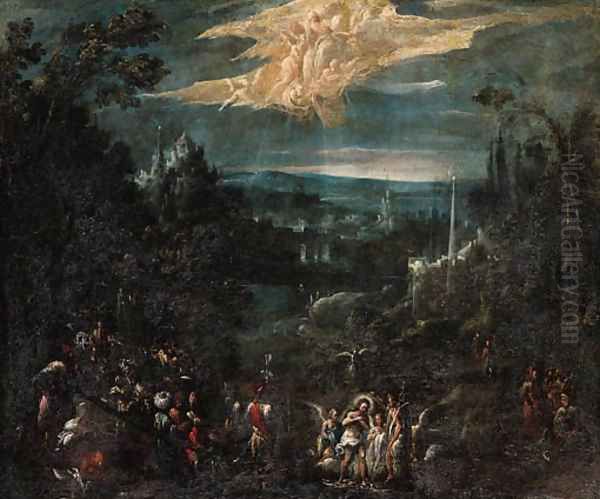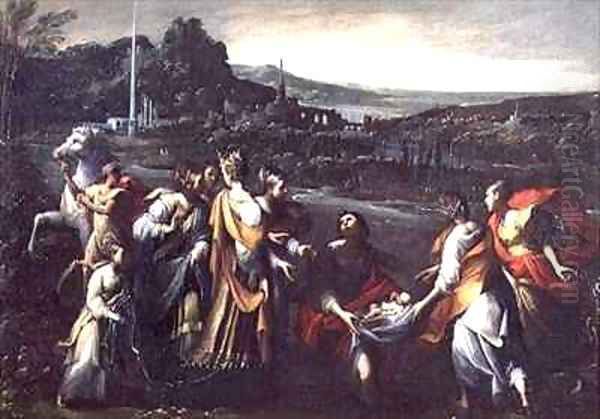Giovanni Andrea Donducci, more famously known by his evocative nickname 'Mastelletta', stands as a distinctive and intriguing figure in the vibrant artistic landscape of early seventeenth-century Italy. Born in Bologna in 1575 and passing away in the same city in 1655, Mastelletta's career unfolded during a period of profound artistic transformation, witnessing the wane of late Mannerism and the ascendance of the dynamic Baroque. Though initially nurtured within the influential Carracci Academy, he forged a highly personal style characterized by spirited brushwork, dramatic chiaroscuro, and a particular affinity for landscape, setting him apart from many of his Bolognese contemporaries.
Early Life and Artistic Formation in Bologna
Bologna, at the close of the sixteenth century, was a veritable crucible of artistic innovation. The dominant force was the Accademia degli Incamminati, founded by Ludovico Carracci and his cousins, Agostino and Annibale Carracci. This academy championed a reform of painting, advocating a return to the study of nature and the High Renaissance masters, moving away from the perceived artificiality of late Mannerism. It was into this stimulating environment that the young Donducci was immersed.
His primary tutelage came under the Carracci, and the influence of Ludovico Carracci, in particular, can be discerned in some of his earlier religious works. Ludovico's emphasis on emotional intensity and devout piety left an imprint on many Bolognese artists. However, Mastelletta was not one to be a mere follower. While absorbing the lessons of the Carracci, particularly their emphasis on drawing and composition, he soon began to cultivate a more idiosyncratic approach. His brushwork became notably free and energetic, and he developed a keen interest in the expressive potential of light and shadow, a hallmark that would define much of his oeuvre.
The Development of a Unique Stylistic Voice
Mastelletta's departure from a strictly Carraccesque manner is evident in his increasingly dynamic compositions and his distinctive handling of paint. He was known for a "pittura di tocco" – a style characterized by visible, often rapid, and spirited brushstrokes that lent an almost impressionistic vivacity to his surfaces. This technique, combined with his penchant for strong contrasts between light and dark (chiaroscuro), created works of considerable dramatic impact.

Art historians note that his style, while rooted in the Baroque's love for dynamism and emotionalism, retained certain elements that could be traced back to Mannerist elegance and sometimes even an almost calligraphic quality in his figures. This fusion contributed to his unique artistic signature. He was less concerned with the idealized anatomical perfection sought by some of his peers, like Guido Reni or Domenichino (fellow Carracci pupils who achieved great fame), and more invested in conveying mood, atmosphere, and narrative energy.
His works often feature elongated figures, animated gestures, and a sense of movement that can feel both restless and poetic. It's been suggested that Mastelletta sometimes used deep shadows to strategically mask areas where his draughtsmanship might have been less rigorous, while simultaneously employing brilliant highlights to capture the viewer's eye and direct it towards the focal points of his compositions. This was a clever and effective visual strategy.
Influences Beyond the Carracci: Ferrarese and Roman Encounters
While the Carracci provided his foundational training, Mastelletta's artistic vision was also enriched by other influences. The art of nearby Ferrara, with its tradition of atmospheric and often fantastical painting, seems to have resonated with him. Artists like Ippolito Scarsella, known as Scarsellino, whose works often featured small figures in rich, evocative landscapes with a particular sensitivity to light, may have offered a congenial model. The Ferrarese tendency towards a more personal and sometimes eccentric mode of expression likely appealed to Mastelletta's own artistic temperament.
A crucial period for Donducci was his time spent in Rome, likely occurring before 1610, or in the years immediately following. The Eternal City was then a melting pot of artistic currents. The revolutionary naturalism of Caravaggio was sending shockwaves through the art world, while the classical ideals championed by Annibale Carracci (who had moved to Rome) were also highly influential. In this environment, Mastelletta appears to have been particularly drawn to the work of Northern European artists active in Rome, such as the German painter Adam Elsheimer and the Flemish landscape specialist Paul Bril.
Elsheimer, renowned for his small-scale paintings on copper, often depicting biblical or mythological scenes within meticulously rendered, poetic landscapes illuminated by innovative light effects (moonlight, firelight), was a significant inspiration for many artists. Similarly, Paul Bril, and later Agostino Tassi, were instrumental in developing the classical landscape tradition in Rome. The influence of these artists, along with perhaps Carlo Saraceni, who navigated a path between Caravaggism and Venetian colorism, can be seen in Mastelletta's growing commitment to landscape painting and his sophisticated treatment of atmospheric effects.
Major Works and Thematic Concerns

Mastelletta's oeuvre encompasses both religious subjects and landscapes, often intertwined. Among his notable religious paintings is the Mystical Marriage of St Catherine. This work, while showing an awareness of Ludovico Carracci's approach to devotional imagery, also displays Mastelletta's characteristic fluid brushwork and dramatic lighting. Another significant religious piece is the Assumption of the Virgin, which again demonstrates his ability to handle complex multi-figure compositions with a sense of dynamic energy. These works often reveal his study of other masters too, including perhaps the earlier Mannerist elegance of Parmigianino, whose graceful and elongated figures had a lasting impact on Emilian painting.
His engagement with biblical narratives often took on a particularly dramatic and scenic quality, as seen in works like The Crossing of the Red Sea (also referred to as Parting of the Waters), a version of which is housed in the Galleria Spada in Rome. Such compositions allowed him to combine his skill in figure painting with his burgeoning interest in landscape and atmospheric effects, creating scenes of epic scope and vivid storytelling. Soldiers on the March is another example where figures are integrated into an expansive, atmospherically charged setting.
The frescoes executed between 1613 and 1614 in the Cappella di San Domenico (Chapel of Saint Dominic) within the Basilica of San Domenico in Bologna represent a major public commission and a testament to his standing in his native city. These works, depicting miracles associated with Saint Dominic, were part of a significant decorative program in one of Bologna's most important churches. Such commissions were highly prestigious and indicate the esteem in which Mastelletta was held by ecclesiastical patrons. It's noted that these frescoes were sometimes associated with local legends of religious marvels, adding another layer to their significance for the contemporary audience.
Mastelletta the Landscapist
While his religious paintings were important, Mastelletta's landscapes are perhaps where his originality shines most brightly. He developed a distinctive style of landscape painting that was highly sought after, particularly by private collectors. These were not always pure landscapes in the modern sense but often featured small figures enacting biblical, mythological, or pastoral scenes, a common practice in the era.
His landscapes are characterized by a sense of romanticism and a slightly wild, untamed quality. He excelled at capturing the play of light through foliage, the hazy distances of a receding vista, and the overall mood of a scene. The influence of Northern landscapists like Bril and Elsheimer is evident in the attention to detail and the creation of a specific atmosphere, yet Mastelletta's touch is always recognizable – his feathery trees, his dynamic skies, and his characteristically spirited application of paint. These works found favor among Roman aristocratic families and contributed significantly to his reputation beyond Bologna.
Collaborations and Artistic Circle
The art world of seventeenth-century Italy was often collaborative. While Mastelletta is primarily known as an independent master, there is evidence of interaction with other artists. One documented instance is a Madonna and Child created in conjunction with Amico Aspertini. Aspertini was an older Bolognese artist known for his highly eccentric and expressive style, drawing on a wide range of influences from antiquity to Northern European art. The nature of their collaboration on this specific piece would be interesting to study further, as their individual styles were quite distinct, though both shared a certain anti-classical verve.
His connection to Pietro Faccini, another Bolognese painter who, like Mastelletta, developed a very personal and expressive style somewhat divergent from the mainstream Carracci school, is also noteworthy. Faccini's agitated brushwork and intense emotionalism may have found an echo in Mastelletta's own work. Furthermore, his style shows an awareness of other Bolognese figures such as Giovanni Battista Bertucci, though Mastelletta's path was ultimately his own.
Anecdotes and Personal Character
Historical records sometimes offer glimpses into an artist's personality. One anecdote recounts that Donducci, seeking peace and quiet for his work, once retreated to the area of Sasso Marconi, a locality in the Apennine hills near Bologna. However, he found himself unable to tolerate the sounds of local music, perhaps the rustic tunes of the countryside, which apparently disturbed his concentration or aesthetic sensibilities. This small detail paints a picture of an artist perhaps sensitive and particular in his working habits.
His works were distributed and appreciated, with pieces finding their way into important collections like the Galleria Spada in Rome. While some contemporary or later critics might have found fault with aspects of his drawing, his originality, his mastery of light, and the sheer verve of his painting were generally recognized and admired. He secured important commissions not only in Bologna but also received attention from patrons in Rome, indicating a career of considerable success.
Later Career, Death, and Legacy
Giovanni Andrea Donducci continued to be active in Bologna throughout the first half of the seventeenth century. He remained a distinctive voice, even as other trends in Baroque painting emerged, such as the more classical and monumental style of artists like Guercino (Giovanni Francesco Barbieri) in his later phases, or the High Baroque exuberance that would characterize later decades.
Mastelletta passed away in Bologna in 1655, leaving behind a substantial body of work that testifies to his unique artistic journey. He was an artist who, while trained in one of the most influential academies of his time, dared to cultivate a highly personal and expressive style. His contributions to landscape painting were particularly significant, anticipating some of the more romantic and atmospheric approaches to the genre that would develop later.
His influence can be seen in the work of some subsequent Bolognese painters, and his paintings continued to be collected and appreciated for their distinctive qualities. Though perhaps not as universally famous today as some of his Carracci-trained contemporaries like Reni or Domenichino, Mastelletta holds an important place as an artist who enriched the Bolognese school with his spirited brushwork, his dramatic use of chiaroscuro, and his poetic interpretations of both religious narratives and the natural world. He remains a compelling example of the diversity and innovative spirit that characterized Italian art during the Baroque era. His ability to synthesize influences from the Carracci, Ferrarese painting, and Roman-based Northern artists into a coherent and personal vision marks him as a true original.